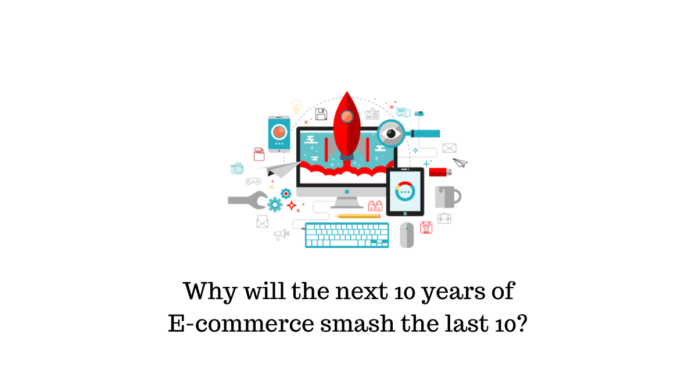The upcoming decade will be fascinating, mainly if you are on the cutting edge of emerging technologies. Overall, you can bank on e-commerce’s future and emerging technologies such as The Metaverse and Web verse to improve how we buy stuff online over the coming years. We cannot discuss eCommerce’s future without discussing the growing physical retail space versus the online debate. The tech is constantly growing, and this article will look at the impact of Google and the upcoming time of the web spider, crawlers, and the next 10 years of E-commerce in a digital era.


You can see a transformation in significant eCommerce Development Agencies today, and the trend will only grow further into the future. The most prominent players in e-commerce are already cashing in on consumers’ willingness to support smaller or local businesses, selling access to tools and software; access to audiences and technology. The mobile market has been increasingly developed over the past year, holding 70% of eCommerce traffic. However, it is not only mobile marketing that is expected to grow in importance to e-commerce businesses. Not to be outdone, the online pet industry, online fashion, and the beauty & cosmetics sectors also saw a substantial market share growth, although not nearly as fast.
While store sales still represent almost 90% of total retail sales, the total US online retail sales share is now higher than total sales in the physical merchandise category for the first time. The increase in e-commerce represents 9% of total retail sales from a year ago.
Worldwide, e-commerce sales exceeded $3.5 trillion, up about 18 percent year-over-year. However, retail still towers above eCommerce sales by more than 15 trillion dollars in terms of sheer dollars. The best eCommerce development companies in the USA contribute on a much larger scale to make online market share more prosperous.


According to statistics, global e-commerce retail sales push back global retail markets share. In 2017, e-commerce retail sales globally totaled $2.3 trillion, with the projected revenue for e-commerce growing to $4.88 trillion US dollars by 2022.
It is estimated that e-commerce retail sales in 2022 will comprise 17.5% of total retail sales globally. The worldwide retail sales from e-commerce have achieved 265% growth, increasing from US$1.3 trillion (2014) to US$4.9 trillion (2022). E-commerce has developed along with other Internet-based industries to become vital in online and brick-and-mortar businesses.
Business-to-business (B2B) e-commerce is all about selling products and services among businesses through online stores. Direct To Consumer (DTC) is a subset of B2C e-commerce, different from eCommerce businesses selling via other retailers or online marketplaces such as Amazon. With DTC, the eCommerce storefront, the online market, social commerce, and the digital community have become the purchase points. Brick-and-mortar stores are slowly finding a niche in the online-selling, e-commerce-dominated world. Still, many customers will shift their purchasing habits to buy nearly everything online, and it will automatically boost your eCommerce business.
Moreover, statistics indicate that nearly 95% of all purchases will occur through eCommerce by the year 2040, certainly a thought-provoking point for all entrepreneurs.
Brick-and-mortar stores also benefit from e-commerce technologies, and understanding e-commerce is about shining a light on bad brands rather than killing brick-and-mortar retail. Those brands who embrace technology building to e-commerce, and understand why e-commerce is such a powerful force, can and will prosper, even as they preserve their brick-and-mortar locations.
That is precisely why a considerable part of the e-commerce future will revolve around businesses and entrepreneurs finding ways to form direct relationships with their customers. For traditional companies, a study says information technology and e-commerce across borders have excellent opportunities to develop and grow businesses rapidly. However, another prevalent myth is that advanced technologies, which are helpful in driving sales on the Internet, are restricted to companies engaged in e-commerce.
Physical stores outperformed e-commerce last year and continue to do so this year. It is estimated that 12,000 retail locations are expected to close this past year, but do not let that headline color your view: What died in malls is being revived online, and what was born online is crossing into the physical world more and more.
Alongside those sales is considerable concern about the death of physical retailing due to online shopping, a raft of headline-grabbing store closings, and bankruptcies over the past few years that appear to back up this theory. In 2018, US retail eCommerce sales were $504.6 billion, according to Statista. Moreover, with 16.1% of all retail sales expected to occur online in 2022, manufacturers and mainstream brands are increasingly moving past retailer’s partners and selling direct-to-consumer.


What to expect in the next 10 years of E-commerce?
When considering US eCommerce share for 2022, the ten most prominent online retailers represent 60%; Amazon, an impressive 38%. Much of the growth in eCommerce is attributed to Amazon, which is growing above-market rates and is expected to represent 37.7% of US online sales in 2019. China, which had $1.9 trillion worth of estimated e-commerce sales in 2019, had online sales that were three times bigger in numbers than those of the United States
Retail sales in the eCommerce sector indicate a substantial influence of COVID-19, and sales are expected to reach $6.5 trillion by 2023. The compound annual growth rate for e-commerce is expected to exceed in-store retail sales by almost nine times.
With the Mobile Billing Industry earning $175.4 Billion in profit, e-commerce continues to reach higher results and incorporates new trends. However, Google’s core business has been losing market share steadily to Amazon, and Google’s failed attempts to capitalize on the opportunity of e-commerce are some of the biggest mistakes I have witnessed.
Over the past two years, the mobile market has been maturing, and it is on pace to hit 70 percent of eCommerce traffic by the end of 2023. M-commerce, or Mobile Commerce, is already over 57% of the online retail industry, and without a doubt, M-commerce will keep growing over the next few years. With the number of mobile devices expected to reach $195.4 billion in revenues in the year 2023, shopping on the go will continue to be relevant as always in 2022 and the coming years. Whether usage grows slowly or explodes, it is clear that voice-controlled shopping will be part of the future of e-commerce.
To Conclude
As voice technologies evolve at an extremely rapid pace, they are already a part of the everyday e-commerce experience and will become more present in online shopping. While everything may seem like evolving in the world of e-commerce, we have narrowed it down to the most prominent trends impacting businesses over the coming months and years. For eCommerce entrepreneurs, staying on top of industry trends is especially important to remain competitive and spot new opportunities. In addition, incorporating new strategies, such as creating physical stores alongside your e-commerce business, will increase sales even more in the coming years.











